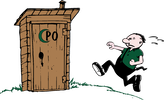hazard assessments
hazards are those that are foreseeable and reasonably likely to occur. The purpose of the hazard assessment is to identify and evaluate those conditions that could lead to workers getting hurt or becoming ill. Assessing hazards involves taking a look at what could harm workers at a workplace. The typical question to ask is “What could go wrong?” Doing a hazard assessment allows CPO to decide whether appropriate precautions have already been taken to prevent accidents and injuries, or whether more needs to be done. A formal hazard assessment (JSA) considers the hazards specific to the task being done.
Formal hazard assessments will be conducted (or reviewed):
It is the intent of CPO to provide a healthy and safe work environment for all job tasks that are to be performed. Proper hazard identification and controls will provide workers with proper direction in the safe performance of their tasks. All CPO workers required to perform hazardous tasks, will receive appropriate instruction and training. Written copies of safe work procedures will be accessible and available to all workers.
It is CPO’s policy and practice to:
Work being performed outside regular controlled environments must have a field level hazard assessment completed by the workers prior to the commencement of work. Any unresolved hazards will be discussed and resolved prior to the commencement of work at the pre-job meeting.
Whenever a new job task or piece of equipment is implemented or acquired, a written formal hazard assessment (JSA) will be completed, which will assist in the development of adequate controls. Written procedures and proper training will precede the performing of the new task or use of the new equipment. CPO must be able to demonstrate that all existing and potential hazards have been identified. The hazard assessment need only include those hazards that apply, or are reasonably likely to apply, to CPO. The hazard assessment report must be dated to confirm when it was completed and how current it is. A manager and field worker will assist in the formal hazard assessment and development of the controls.
Written procedures will be prepared or revised when any of the following occur:
Formal hazard assessments will be conducted (or reviewed):
- Annually
- When changes are made to the operation or work-related process
- When a new work process is introduced
- When a temporary or mobile work process is introduced
- When site-specific hazard assessments identify a new hazard
- When an inspection identifies a new hazard
- When an investigation identifies a new hazard
It is the intent of CPO to provide a healthy and safe work environment for all job tasks that are to be performed. Proper hazard identification and controls will provide workers with proper direction in the safe performance of their tasks. All CPO workers required to perform hazardous tasks, will receive appropriate instruction and training. Written copies of safe work procedures will be accessible and available to all workers.
It is CPO’s policy and practice to:
- assess the hazards of the workplace, job tasks, environment where the job tasks are being completed,
- eliminate or minimize the dangers of these hazards,
- ensure all workers understand the nature of the workplace hazards and use safe work practices, and
- ensure workers receive training in the proper handling, use, and disposal of hazardous materials.
Work being performed outside regular controlled environments must have a field level hazard assessment completed by the workers prior to the commencement of work. Any unresolved hazards will be discussed and resolved prior to the commencement of work at the pre-job meeting.
Whenever a new job task or piece of equipment is implemented or acquired, a written formal hazard assessment (JSA) will be completed, which will assist in the development of adequate controls. Written procedures and proper training will precede the performing of the new task or use of the new equipment. CPO must be able to demonstrate that all existing and potential hazards have been identified. The hazard assessment need only include those hazards that apply, or are reasonably likely to apply, to CPO. The hazard assessment report must be dated to confirm when it was completed and how current it is. A manager and field worker will assist in the formal hazard assessment and development of the controls.
Written procedures will be prepared or revised when any of the following occur:
- A new activity or equipment have been introduced
- New Regulations are implemented that affect a specific written procedure
- Inspection reports indicate changes
- Incident investigations indicate changes
- New specifications are implemented.
- First aid records indicate a trend and need
- Worker suggestions are received and valid
- Safety committee requests changes
- Hazard assessments indicate the need for change


